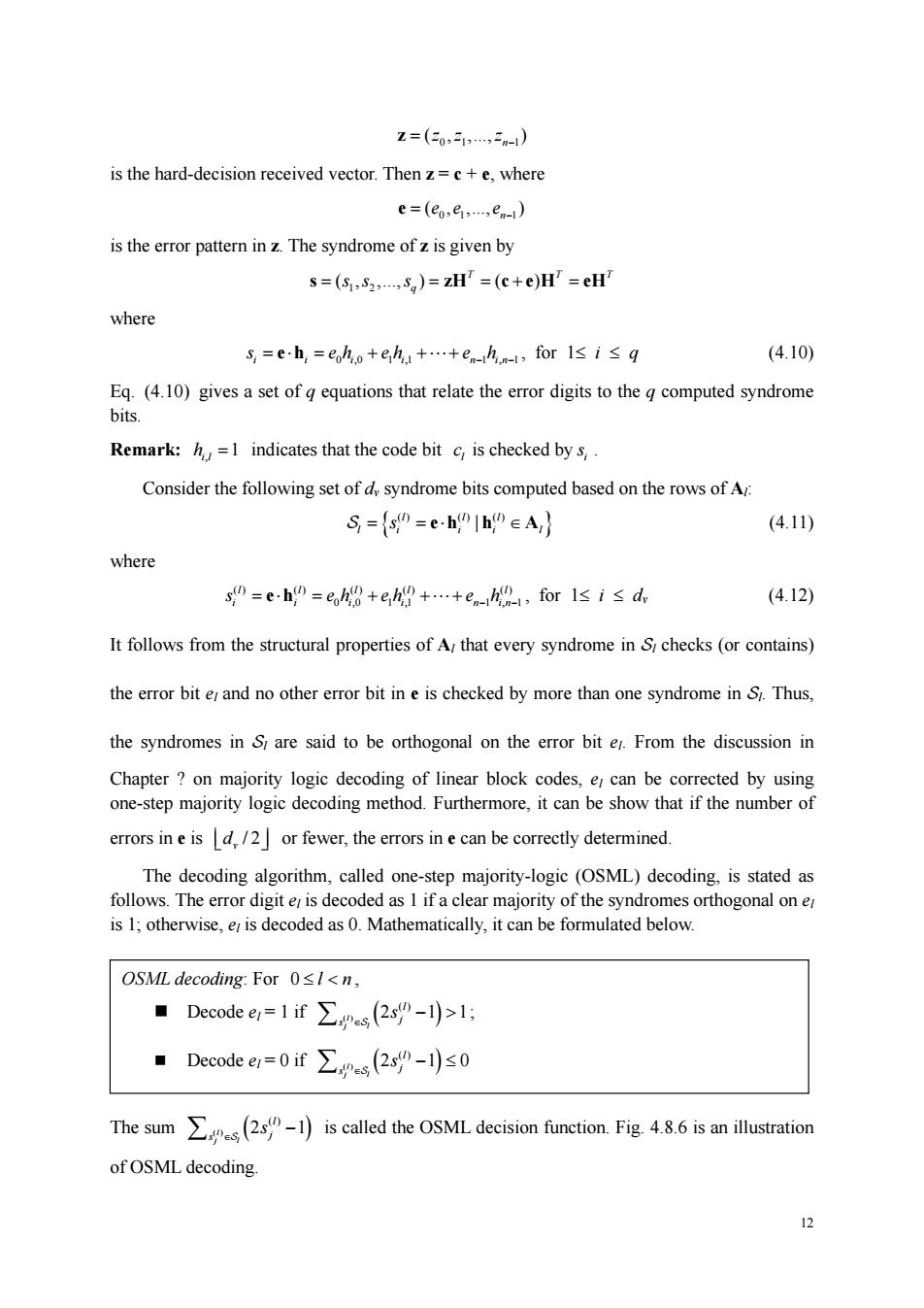正在加载图片...

z=(50,51,20-i) is the hard-decision received vector.Thenz=c+e,where e=(eoes.e) is the error pattern in z.The syndrome of z is given by s=(S,52,3,)=zH=(c+e)H=eH where s=eh,=eho+eht.+enhn-l,for Isi≤g (4.10) Eq.(4.10)gives a set of g equations that relate the error digits to the g computed syndrome bits. Remark:=1 indicates that the code bit c is checked bys Consider the following set of d,syndrome bits computed based on the rows of Ar. S=sh =e.h(h eA (4.11) where s =e.h =eoh +eh +.+n,for Is i s dy (4.12) It follows from the structural properties of Ar that every syndrome in Schecks (or contains) the error bit eand no other error bit in e is checked by more than one syndrome in S.Thus. the syndromes in S,are said to be orthogonal on the error bit er.From the discussion in Chapter on majority logic decoding of linear block codes,er can be corrected by using one-step majority logic decoding method.Furthermore,it can be show that if the number of errors ine isd,/2]or fewer,the errors ine can be correctly determined. The decoding algorithm,called one-step majority-logic (OSML)decoding,is stated as follows.The error digit er is decoded as I if a clear majority of the syndromes orthogonal on er is otherwise,eis decoded as .Mathematically,it can be formulated below. OSML decoding:For 0sI<n, ·Decode e1=1if∑ges(2s9-l>l ·Decode1=0if∑.s2s"-l)s0 The sum(2s-1)is called the OSML decision function.Fig.4.8.6 is an illustration of OSML decoding. 12 01 1 ( , ,., ) n zz z = − z is the hard-decision received vector. Then z = c + e, where 01 1 ( , ,., ) n ee e = − e is the error pattern in z. The syndrome of z is given by 1 2 ( , ,., ) ( ) T TT q s zH c e H eH = = =+ = ss s where i i i i n in 0 ,0 1 ,1 1 , 1 s eh eh e h =⋅ = + + + − − e h " , for 1≤ i ≤ q (4.10) Eq. (4.10) gives a set of q equations that relate the error digits to the q computed syndrome bits. Remark: , 1 i l h = indicates that the code bit is checked by l i c s . Consider the following set of dv syndrome bits computed based on the rows of Al: { } () () () | l ll l i ii l S = =⋅ ∈ s eh h A (4.11) where () () () () () 0 ,0 1 ,1 1 , 1 l l ll l i i i i n in s eh eh e h =⋅ = + + + − − e h " , for 1≤ i ≤ dv (4.12) It follows from the structural properties of Al that every syndrome in Sl checks (or contains) the error bit el and no other error bit in e is checked by more than one syndrome in Sl. Thus, the syndromes in Sl are said to be orthogonal on the error bit el. From the discussion in Chapter ? on majority logic decoding of linear block codes, el can be corrected by using one-step majority logic decoding method. Furthermore, it can be show that if the number of errors in e is / 2 v ⎢ ⎥ d⎣ ⎦ or fewer, the errors in e can be correctly determined. The decoding algorithm, called one-step majority-logic (OSML) decoding, is stated as follows. The error digit el is decoded as 1 if a clear majority of the syndromes orthogonal on el is 1; otherwise, el is decoded as 0. Mathematically, it can be formulated below. The sum ( ) ( ) ( ) l 2 1 j l l j s s ∈ ∑ − S is called the OSML decision function. Fig. 4.8.6 is an illustration of OSML decoding. OSML decoding: For 0 ≤ <l n , Decode el = 1 if ( ) ( ) ( ) l 2 11 j l l j s s ∈ ∑ − > S ; Decode el = 0 if ( ) ( ) ( ) l 2 10 j l l j s s ∈ ∑ − ≤ S